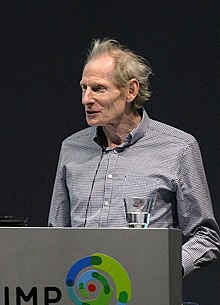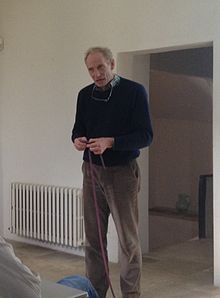Kim Nasmyth
Kim Nasmyth | |
|---|---|
 Kim Nasmyth in October 2017 | |
| Born | Kim Ashley Nasmyth 10 October 1952[4] |
| Nationality | British[5] |
| Education | Eton College |
| Alma mater |
|
| Known for | Cohesin |
| Spouse |
Anna Dowson (m. 1982) |
| Children | Two[4] |
| Awards |
|
| Scientific career | |
| Fields | molecular biology, gene regulation, cell cycle control |
| Institutions | |
| Thesis | DNA replication in Schizosaccharomyces pombe (1977) |
| Doctoral advisor | Murdoch Mitchison[2][3] |
| Notable students | |
| Website | www |
Kim Ashley Nasmyth FRS FMedSci[6] (born 18 October 1952)[4] is an English geneticist, the Whitley Professor of Biochemistry at the University of Oxford, a Fellow of Trinity College, Oxford, former scientific director of the Research Institute of Molecular Pathology (IMP), and former head of the Department of Biochemistry, University of Oxford.[7][8] He is best known for his work on the segregation of chromosomes during cell division.
Early life and education
Nasmyth was born in London in 1952 of James Ashley (Jan) Nasmyth and Jenny Hughes.[4][9] His father Jan was doubly descended from King Charles II and founder of the billion dollar publishing company Argus Media.[9][10] He attended Eton College, Berkshire, then the University of York, where he studied Biology.[4] Nasmyth went on to complete his graduate studies in the group of Murdoch Mitchison at the University of Edinburgh. Here he worked on the cell cycle alongside Paul Nurse[3] and his PhD thesis focused on the control of DNA replication in fission yeast.[2] In Mitchison's lab he made substantial contributions to the study of the cell cycle in fission yeast isolating and characterising cell cycle mutants and the first identification of a gene product (DNA ligase) in these mutants.[11]
Career and research


Nasmyth joined Ben Hall's lab in Seattle as a postdoctoral researcher where he developed ways of cloning genes by complementation in yeast and, in collaboration with Steve Reed, cloned the CDC28 gene from the budding yeast Saccharomyces cerevisiae.[3]
As a group leader in Cambridge Nasmyth became interested in the phenomenon of mating-type switching in yeast. Together with Kelly Tatchell he cloned the S. cerevisiae mating-type locus and found, surprisingly, that 'silent' copies of the mating-type genes including their promoters are maintained in the yeast chromosome. This represented the first case where the position of a gene in the chromosome had demonstrable biological significance, and prompted Nasmyth to abandon work on the cell cycle for a time and concentrate instead on studying gene silencing.[3] He was one of the first to demonstrate that gene expression can be regulated through specific control elements which are distant from the start of transcription.[11]
Max Birnstiel invited Nasmyth to join him at the then newly founded Research Institute of Molecular Pathology (IMP) in Vienna, Austria, where he was director. Nasmyth became one of the first three senior group leaders that Birnstiel recruited in 1986.[12] At the IMP, Nasmyth changed his focus from gene silencing back to cell cycle control. In the mid-1990s Nasmyth co-discovered the APC/C and showed that its activity induces chromosome segregation.[13] Using temperature-sensitive mutants of the APC/C he found several genes which are required for sister chromatid cohesion[14] which we now know encode subunits of the cohesin complex. Nasmyth has since shown that cohesin forms a ring,[15] that sister chromatids are held together within this ring[16] and that they are released by cleavage of cohesin by separase.[17] Following Max Birnstiel's retirement, Nasmyth became scientific director of the IMP in 1997.[18]
In 2006, Nasmyth left the IMP to become head of the Department of Biochemistry of the University of Oxford, a post he held until 2011. Nasmyth continues to head a research group at this department. He is a member of the Advisory Council for the Campaign for Science and Engineering.[19][20][21] His research has been funded by the Medical Research Council (MRC), the Wellcome Trust, and Cancer Research UK.[22][23][24][25] He plans to retire from research in 2022.[24]
Awards and honours
Nasmyth has also been awarded the following:
- 1985 Member of the European Molecular Biology Organization
- 1989 Elected a Fellow of the Royal Society[6]
- 1995 FEBS Silver Medal [26]
- 1996 Unilever Science prize [26]
- 1997 Louis-Jeantet Prize for Medicine[27]
- 1999 Wittgenstein-Preis[28]
- 1999 Foreign Honorary Member of the American Academy of Arts and Sciences[26]
- 2002 Croonian lecture/Medal of the Royal Society [26]
- 2003 Boveri award for Molecular Cancer Genetics [26]
- 2007 Gairdner Foundation International Award[26]
- 2009 Elected a Fellow of the Academy of Medical Sciences (FMedSci)[29]
- 2018 Breakthrough Prize in Life Sciences[30]
Personal life
Nasmyth married Anna Dowson, daughter of Sir
References
- ^ Louis-Jeantet Prize
- ^ EThOS uk.bl.ethos.659887.

- ^ PMID 9550707.
- ^ doi:10.1093/ww/9780199540884.013.29204. (Subscription or UK public library membershiprequired.)
- ^ a b "Kim NASMYTH - Personal Appointments (free information from Companies House)". beta.companieshouse.gov.uk. Retrieved 5 December 2017.
- ^ a b "Professor Kim Nasmyth FMedSci FRS". London: Royal Society. Archived from the original on 17 November 2015.
- ^ .
- S2CID 34939988.
- ^ ISSN 0307-1235. Retrieved 5 December 2017.
- ^ "James Ashley (Jan) Nasmyth (1918-2008)". groups.google.com. Retrieved 5 December 2017.
- ^ a b "DServe Archive Catalog Show". collections.royalsociety.org. Retrieved 4 March 2016.
- ^ "History of the IMP". Retrieved 29 November 2017.
- S2CID 15424287.
- S2CID 18572651.
- S2CID 15563936.
- PMID 25414305.
- S2CID 2667617.
- ^ "IMP Management". Retrieved 29 November 2017.
- ^ "Advisory Council of the Campaign for Science and Engineering". Archived from the original on 28 August 2010. Retrieved 11 February 2011.
- PMID 9990856.
- PMID 10827941.
- ^ "UK Government research grants awarded to Kim Nasmyth". Swindon: Research Councils UK. Archived from the original on 3 June 2015.
- ^ "Kim Nasmyth : Cancer Research UK". 15 November 2015. Archived from the original on 15 November 2015. Retrieved 5 December 2017.
{{cite web}}: CS1 maint: bot: original URL status unknown (link) - ^ a b Oneltd (17 November 2015). "Trinity College – Professorial Fellow wins Wellcome Trust award". trinity.ox.ac.uk. Retrieved 5 December 2017.
- ^ "Lord of the Rings – Cohesin and cancer". Cancer Research UK - Science blog. Retrieved 5 December 2017.
- ^ a b c d e f "Keynote Lectures Detailed Information".
- ^ de médecine 1997 and Travaux de recherche Archived 30 January 2016 at the Wayback Machine
- ^ Wittgensteinpreis-Träger 1999 Univ. Prof. Dr. Kim Ashley Nasmyth Archived 8 June 2015 at the Wayback Machine
- ^ "Professor Kim Nasmyth | the Academy of Medical Sciences".
- ^ Breakthrough Prize in Life Sciences 2018
- ^ "CSHL Archives Repository | Invitation to the marriage of Kim Nasmyth and Anna Dowson". libgallery.cshl.edu. 1982. Retrieved 4 December 2017.
- ISBN 9780500022542.
- ^ "These 12 People Are Changing Science". Time. Retrieved 5 December 2017.
- ^ Breakthrough (3 December 2017), LIVE - Morgan Freeman hosts the Breakthrough Prize | Nat Geo Live, retrieved 4 December 2017
- ^ "Le Mazelet | Le Mazelet". lemazelet.com. Retrieved 5 December 2017.
- ISSN 0307-1235. Retrieved 5 December 2017.
- ^ "ARGUS MEDIA LIMITED - Annual return made up to 7 June 2016 with full list of shareholders". beta.companieshouse.gov.uk. Retrieved 5 December 2017.
- ^ "DerStandard.at".
